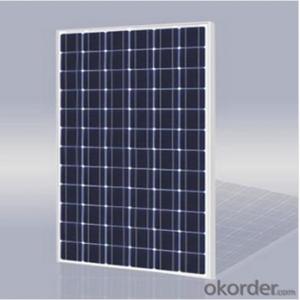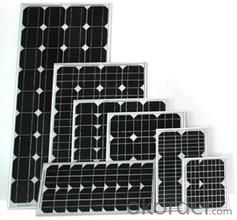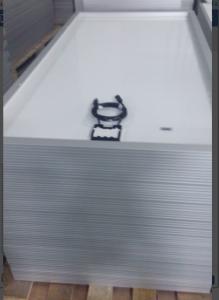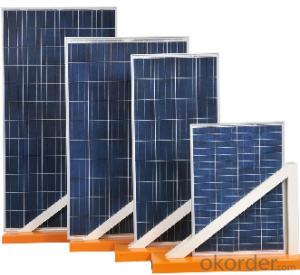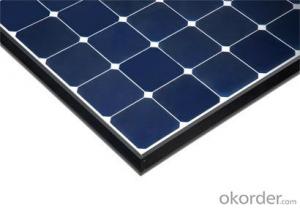Telsa Solar Panels - Poly Solar Panel 285w A Grade with Cheapest Price
- Loading Port:
- Shanghai
- Payment Terms:
- TT OR LC
- Min Order Qty:
- 100 watt
- Supply Capability:
- 50000 watt/month
OKorder Service Pledge
OKorder Financial Service
You Might Also Like
Specification
Poly Solar Panel 285W A Grade with Cheapest Price
Product description
60 cell multi-crystalline solar module. 40mm natural anodised frame. IP65 rated Jbox, 1m solar cable and a pair of MC4 connectors.TÜV SÜD,SABS ISO 9001:2008 certified.
Nominal voltage refers to the voltage of the battery that the module is best suited to charge; this is a leftover term from the days when solar modules were only used to charge batteries. The actual voltage output of the module changes as lighting, temperature and load conditions change, so there is never one specific voltage at which the module operates. Nominal voltage allows users, at a glance, to make sure the module is compatible with a given system.
Open circuit voltage or VOC is the maximum voltage that the module can produce when not connected to an electrical circuit or system. VOC can be measured with a meter directly on an illuminated module's terminals or on its disconnected cable.
Chemicals such as Boron (p-type) are applied into the semiconductor crystal in order to create donor and acceptor energy levels substantially closer to the valence and conductor bands.
The basis of producing solar panels revolves around the use of silicon cells.[28] These silicon cells are not efficient enough in their current state and can only convert solar energy [29] in to usable power at a rate of roughly 10-20 percent.[30] In order for solar panels to become more efficient, and therefore more useful in the future, researchers across the world have been trying to develop new technology to make solar panels more effective at turning the sun in to energy.[31]
Application
Industrial
Commercial
Residential
Product feather
solar panel refers to a panel designed to absorb the sun's rays as a source of energy for generating electricity or heating.
A photovoltaic (in short PV) module is a packaged, connected assembly of typically 6×10 solar cells. Solar Photovoltaic panels constitute the solar array of a photovoltaic system that generates and supplies solar electricityin commercial and residential applications. Each module is rated by its DC output power under standard test conditions, and typically ranges from 100 to 365 watts. The efficiency of a module determines the area of a module given the same rated output – an 8% efficient 230 watt module will have twice the area of a 16% efficient 230 watt module. There are a few solar panels available that are exceeding 19% efficiency. A single solar module can produce only a limited amount of power; most installations contain multiple modules. A photovoltaic system typically includes a panel or an array of solar modules, a solar inverter, and sometimes a battery and/or solar tracker and interconnection wiring.
Packaging
24-26pcs into carton 312pcs for 20 foot container 712pcs for 40 foot container.
- Q: Can solar panels be used in combination with other renewable energy sources?
- Yes, solar panels can indeed be used in combination with other renewable energy sources. Many renewable energy systems today incorporate a mix of solar panels, wind turbines, hydropower, and geothermal energy to maximize efficiency and ensure a reliable and sustainable power supply. This combination of different renewable sources allows for a more balanced and consistent energy generation, reducing reliance on a single source and increasing overall system resilience.
- Q: Can solar panels be installed on a data center or technology facility?
- Yes, solar panels can be installed on a data center or technology facility. In fact, many data centers and technology facilities around the world have already adopted solar energy as a means of powering their operations. Solar panels can be installed on rooftops, parking lots, or nearby land to generate clean and renewable electricity, reducing the facility's reliance on traditional power sources and lowering its carbon footprint. This not only helps in reducing energy costs but also contributes to a more sustainable and environmentally friendly operation.
- Q: I am researching several solar panels to install in my house. I would like to use a 40 watt panel to connect, through a solar battery controller, to a battery or two. I would then like to use the solar panel (40 watts) to charge the battery(ies) for emergency use. Once charged, and when needed, I would like to use the battery(ies), 2 volt deep cycle, to power several LED lamps. Since I am new to solar power I had several questions...Is a 40 watt panel strong/large enough to charge a 2 volt deep cycle battery or two?How long would it take to charge one of these batteries?What would be the expected cost to purchase necessary supplies? (With the solar panel, battery controller, and MC4 cabling I've found I have an expected cost of roughly $00.00 with batteries)Would this be difficult for someone with little experience in this field?
- Your demand is high. You require at least 5KVA (5000watts) out put with an appropriate battery storage and inverter..
- Q: Hi, I am starting to get curious about the pros/cons of installing solar panels - has anyone done it and is it worth it?
- Solar is mroe expensive than just about every other form of generation for a centralized plant, but can still be cost-effective for a consumer living in the right place. This is because while a coal-fired plant may produce electricity for 2-3 cents per kWh, by the time it's marked up to retail, distributed, and taxed to get to a residence, it may be 5 cents per kWh - a figure which solar can match in many places.
- Q: They have been around long enough to be cheaper. Unless they are made out of a natural material that is rare and hard to find, there is no reason why they should be so expensive. On another note, I think that all low power devices like cell phones and even laptops should have solar panels. Even if it is not enough to fully power the device for a long period of time, it will provide some electricity savings and with millions of people saving a little power adds up.
- materials and process... if they could be built in a sweatshops, by kids, in Malaysia, they'd be cheap and everyone would use them
- Q: Can solar panels be used to power a mining operation?
- Yes, solar panels can be used to power a mining operation. Solar energy can be harnessed and converted into electricity through photovoltaic panels. This electricity can then be used to power various mining processes such as crushing, grinding, transportation, and ventilation systems. However, the suitability of solar panels for powering a mining operation would depend on factors such as the required energy demand, availability of sunlight, space for installation, and the feasibility of integrating solar power with existing mining infrastructure.
- Q: i am working on a project which requires small solar panels. i am looking for ones about 3X4. is there any way i could get these? and where?
- You could build them yourself? Depending on the time you have.... They are having a special at the moment....
- Q: could any tell me what type off panel is the best tube or flat and how much it should be. I live in N Ireland
- I assume you're talking about heating water. Based on what I've seen, the spiral tubes seem to heat the water to a higher temperature than the flat panels, probably because the water has to follow a longer path and has more time to heat. This type of panel will heat the water to a high enough temperature for almost any household application, but you need to be careful about how you set it up. I once saw a pool that had been equipped with that type of heating system, and it produced enough heat to melt one of the PVC pipes. It was a vertical pipe next to the filter, and it had fallen over onto the ground, pinching off the flow of water. This was in Arizona, so it may not get that hot in your area.
- Q: Can solar panels be used in areas with high levels of dust?
- Yes, solar panels can be used in areas with high levels of dust. However, it is important to note that the efficiency of solar panels may be affected by the accumulation of dust on their surface. Regular cleaning and maintenance can help mitigate any potential decrease in performance caused by dust build-up.
- Q: Heard you can put solar panels on laptops Anyone know if it can work on a Dell mini 0v? I've seen he USB slot solar pana but can someone tell me where to gt these?
- If okorder /
Send your message to us
Telsa Solar Panels - Poly Solar Panel 285w A Grade with Cheapest Price
- Loading Port:
- Shanghai
- Payment Terms:
- TT OR LC
- Min Order Qty:
- 100 watt
- Supply Capability:
- 50000 watt/month
OKorder Service Pledge
OKorder Financial Service
Similar products
Hot products
Hot Searches
